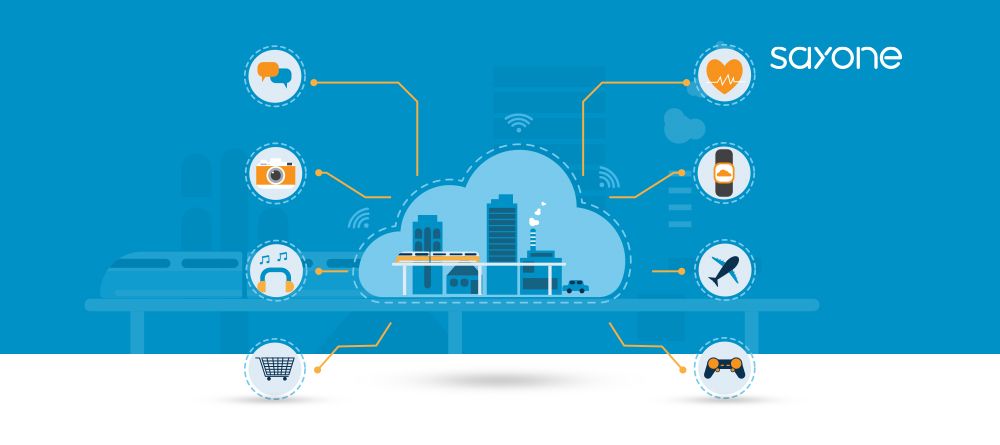
Subscribe to our Blog
We're committed to your privacy. SayOne uses the information you provide to us to contact you about our relevant content, products, and services. check out our privacy policy.

Akhil SundarJune 7, 20239 min read

Generating table of contents...
The Internet of Things fondly referred to as IoT, is changing how many businesses worked up till now. Supply chain management (SCM) is also a sector that has seen many changes coming. IoT basically refers to a network of physical devices, sensors, software, etc., that can collect and share data via the Internet.
Today, IoT has been instrumental in helping varied businesses serve their customers better, reduce the costs of doing business, and improve the efficiency of the supply chain. Supply chain management services company relates to all the activities starting with raw materials and ending with delivering a product to the end consumer.
The SCM is made up of many complex operations, including demand management, product planning and control, inventory management, etc. However, appropriate implementation of IoT in SCM can help to simplify complex processes and drive more revenue.
The supply chain is undoubtedly complex involving myriad processes, stakeholders, and touch-points. Today SCM faces numerous challenges because of these different processes and their speeds.
Lack of visibility is one of the biggest supply-chain challenges. To run a supply chain efficiently, the stakeholders must have clear visibility as regards the movement of goods and materials. Poor visibility naturally leads to delayed and wrong shipments and this leads to a complete loss of control over available resources and their flow.
Managing inventory in SCM boils down to making sure that there are enough raw materials stocked to deliver orders on time. Here, stakeholders face the challenge of managing large volumes of materials. Neither the shortage or excess availability of resources would work; both would seriously affect the process efficiency.
Read out Blog:The Role of IoT in Mobile App Development
Yet another major challenge is managing funds for meeting the expenses. In SCM, almost always, stakeholders are always under pressure because of increasing raw material costs and shipping charges. Moreover, when products have to be delivered to the customer on time, the cash flow related to storage, shipping, transhipment, manufacturing, packaging, distribution, and more have also to be managed.
Customers of today have constantly evolving demands. Managing these ever-changing customer demands is a big challenge for SCM. It is also an integral part of this exercise. If the demand forecast is inaccurate, there is a loss of resources and money and this, in turn, can disrupt the functioning of the supply chain. Stakeholders must strive to gather relevant data from past sales and apply analytics to subsequently create an accurate demand forecast layout so that there is no further resource/money loss.
It is important to realize that by implementing the right technology a number of these problems can be overcome easily. Stakeholders have too many on their hands today, IoT, AI, ML, etc., and are confused about which one to choose. When implemented in the right way, these technologies would be able to offer improved efficiency, better workflow, increased accuracy, etc. Ultimately, the real challenge would lie in choosing the best-suited technology and implementing it properly and effectively in your specific supply chain.
In manufacturing plants, there are two primary components: Operational Technology (OT) and Information Technology (IT). OT refers to systems that control and monitor physical machinery and devices, while IT manages digital information, including computer hardware, software, network infrastructure, storage, and cloud computing.
These two areas are often managed separately due to their distinct personnel, architectures, and protocols, making integration across both legacy and new systems complex. The differences in their processes and languages create a communication gap between IT and OT teams, often exacerbated by outdated or poorly connected networks.
IoT can alter and also digitize the majority of processes related to SCM. This can be accomplished by connecting smart devices and sensors and allowing them to further exchange data with one another. Listed below are a few critical IoT solutions that can work for supply chain management.

One of the best benefits that SCM enjoys with help from IoT is improved real-time visibility. IoT sensors would be able to generate real-time data on the different properties of raw materials and goods. As an example, IoT makes it possible for stakeholders to see the exact location of goods and then make a fair estimate of the delivery time of the goods to the specified destination. IoT further helps to track specific parameters like the temperature and humidity of goods from wherever you are located. This means you can track goods with more accuracy, reduce resource wastage, and also improve overall efficiency.
With IoT in place, it is possible to implement predictive maintenance in the supply chain. Supply chain managers would be able to predict the failure of say, machines, in a process control environment, by analyzing data that is shared by IoT devices and sensors. This can help to cut down costs, cut machine downtime, and improve efficiency. Overall, predictive maintenance helps to improve the performance metrics of the machine and its life.
IoT implementation in SCM also allows for an enhanced customer experience. Data from IoT devices can let customers know the exact location of their goods by providing real-time or live updates. Once they know the correct statuses of their orders, customers are in a better position to manage their affairs related to the delivery of these goods. This in the longer term would serve to improve customer loyalty and lead to improved revenues.
SCM involves several repetitive tasks including data entry, order tracking, sending emails, inventory management, etc. IoT can be implemented in SCM to automate many of these mundane and repetitive tasks. This can help the organization save lots of time and effort and also improve the productivity of the supply chain managers. They can now invest more time in core business needs and strategies than in repetitive tasks. This type of automation helps to improve overall efficiency and also helps to reduce errors.
Inventory management is a challenging task. Using IoT sensors can help businesses to gain real-time insights into their inventory status, and lead them to make informed decisions and further prevent product shortages. Such insights also help to predict future inventory requirements based on customer demands. IoT devices also provide information about physical factors such as leakages, product damage, broken packaging, etc.
IoT solutions can be designed to facilitate asset monitoring and tracking. Here, instead of manually logging in the asset data, supply chain managers can make use of IoT solutions incorporating sensors, RFID tags, etc., to check the status of every asset item. This is a great time saver.

Looking for web or mobile app development services? Call us today!
Implementation of IoT systems in SCM is gathering more steam because of its power to enable more visibility and control over the entire set of operations. SCM is a multifaceted system having many moving parts, and it is not so simple to add an effective IoT solution. Given below are a few points to consider and best practices that you can consider from the very beginning of the implementation.
It is compulsory to have a stable internet connection that will allow you to utilize the full potential of IoT. Therefore, you must check the details with the internet service provider.
Even though most operations will be automated with IoT systems in place, the employees will have to operate devices and gadgets appropriately. This means they must be given adequate training before assigning relevant work.
Read our blog: The Role of Blockchain in Mobile App Development
Security is a major challenge while implementing IoT technology. Therefore, it should be ensured that the IoT solution provider offers the best security options during its implementation.
Be wary of the costs incurred during IoT solution implementation. The costs depend on factors such as the quality and features of the equipment, installation, maintenance, service charges, add-ons, etc.
Make sure that the IoT solution you decide to implement is compatible with your other areas of the supply chain. This helps smooth operation.
Get in touch with us for a FREE consultation!
Implementation of IoT solutions can dramatically improve the performance of a supply chain. And in the long run, it can bring in many more added benefits to all the stakeholders involved.

We're committed to your privacy. SayOne uses the information you provide to us to contact you about our relevant content, products, and services. check out our privacy policy.

About Author
Subject Matter Expert

We collaborate with visionary leaders on projects that focus on quality